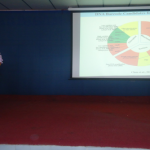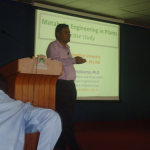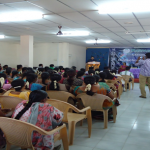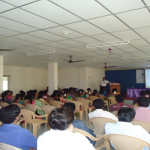Biotechnology is an important tool that can be applied to various economic sectors of special interest to developing countries, such as the production of food crops, livestock management, human health care, chemical industry and environment management. The majority of developing countries including India lack the necessary qualified manpower to exploit such technologies.
Further, Biotechnology, as practiced today, requires inputs from not only one area of biological sciences, but requires a fusion of different modern biological and technological sciences. Biotechnology has become a multi-billion dollar industry all over the world.
The Department of Biotechnology at KAHE is a center for excellence in research, established in 2001. The progress of the department is consistent over the years and presently holds many research projects funded by the UGC, DST, DBT and ICMR. During the last 10 years, the department has made all round progress and is on par with the well established departments of the KAHE. Scholars in the department are pursuing research in the areas of Nano-biotechnology, Food Technology, Fermentation Technology, Plant Tissue Culture, Animal Tissue Culture, Genetics and Molecular Biology, Microbial Technology and Phytochemistry. It is commendable to mention that the department is the proud recipient of Rs. 2.81crores from the Govt. of India for various research and development programmes. Our Department of Biotechnology has been recognized by DST-FIST for research and academic purpose. Various collaborative research projects are going on in our department with many academic and industries including
-JK Nanosolutions, Karnataka, India
-University of Hyderabad, India
-Shiraz University, Shiraz, Iran
-Nanjing Agricultural University, Nanjing, China
-East China Normal University, Shanghai, China
- About
- Academics
- Overview
- Faculty of Arts, Science , Commerce and Management
- Dean
- Department of Biochemistry
- Department of Biotechnology
- Department of Microbiology
- Department of Chemistry
- Department of Physics
- Department of Mathematics
- Department of Computer Applications
- Department of Computer Science
- Department of Computer Technology
- Department of Commerce
- Department of Management
- Department of Languages
- Faculty of Engineering
- Dean
- Department of Artificial Intelligence and Data Science
- Department of Biomedical Engineering
- Department of Biotechnology
- Department of Chemical Engineering
- Department of Civil Engineering
- Department of Computer Science and Engineering
- Department of Electrical and Electronics Engineering
- Department of Electronics and Communication Engineering
- Department of Food Technology
- Department of Mechanical Engineering
- Supportive Department
- Faculty of Architecture, Design and Planning
- Faculty of Pharmacy
- Library
- Regulations
- NEP
- Discipline
- Best Practices
- Capacity Development and Skills Enhancement Initiatives
- Institutional Distinctiveness
- Course Outcomes
- IT Policy
- Energy Efficiency and Clean Energy Policy 2023
- Environmental Quality and Energy Policy 2023
- Smoke Free Campus Policy 2023
- Strategic Plan and Deployment Documents
- List of Dedicated courses on SDG
- Organogram
- Reports
- Admissions
- Examinations
- IQAC
- Research
- Overview
- Research Programmes
- Timeline Presentation
- Center of Excellence
- Funded Research Projects / Other Grants / Awards
- Patents
- Research Publications
- Research Consultancy
- List of PhD Research Scholars
- Research Policy and Guidelines
- Research Opportunities
- List of PhD Research Supervisors
- Viva-voce Examination through Video Conference
- Annual Research Congress
- Research Database
- Consultancy Policy
- Office of International Affairs
- Training & Placement
- Campus Life







